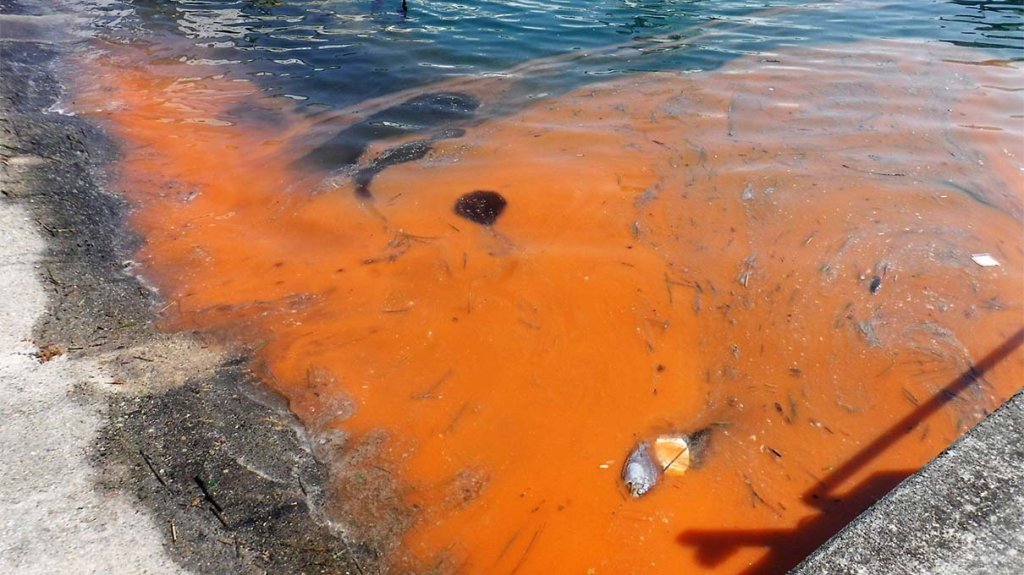
A new task force will focus on red tide the same way another has turned its attention to blue-green algae.
Gov. Ron DeSantis announced the appointment of 11 individuals to the newly revitalized Red Tide Task Force.
“My administration will continue to press forward to find solutions and empower our brightest minds to help protect our environment. The issues of Red Tide are complex, but with the appointments of these leading scientists and researchers, we hope to make a difference.”
DeSantis made the announcement from Sandbar Tiki & Grille in Englewood, where he met with environmental activists during his gubernatorial campaign last year.
At the time, he said the impact of red tide on the fishing, hospitality and restaurant economy became clear.
“We are here today to announce a lot of great people serve on this task force,” he said. “We look forward to seeing what they can do.”
Noah Valenstein, the Environmental Protection Secretary, said the new force would work in close alignment with the Blue Green Algae Task Force appointed by DeSantis in April. That board just held its third meeting yesterday in Fort Pierce.
“It’s amazing the forward progress when put some of the brightest academic minds together,” Valenstein said. “Now we expect the same type of dynamic conversation and forward momentum on red tide.”
The Legislature this year budgeted $4.8 million for the task force, which had been dormant for about 15 years.
DeSantis made clear the work by the new task force would different significantly from the Florida Red Tide Mitigation and Technology Development Initiative.
That new initiative, a partnership between Mote Marine Laboratory in Sarasota and the Florida Fish and Wildlife Rearch Institute, will focus on response. The Red Tide Task Force will look toward prevention.
“One of the things I’ve been concerned about is whether the nutrients pushed from Lake Okeechobee into the freshwater exacerbated red tide,” DeSantis said. “Some think so but I don’t think we know definitively.”
Part of the focus of the task will be on identifying the source of nutrients that feed red tide, which always lived in the Gulf of Mexico but frequently blooms to impact life on shore.
Last year, the state saw the worst algal bloom on record, and the worst since 1953 to impact three regions of the state significantly.
Environmental and fishing groups praised the establishment of the red tide task force.
“Today’s announcement of a Red Tide Task Force, which will complement current efforts of the Blue-Green Algae Task Force, is yet another reason why Gov. DeSantis is Florida’s environmental governor,” said Gary Jennings, director of Keep Florida Fishing.
“His reorganization and reactivation of the Red Tide Task Force, with an initial $4.8 million allocation, will not only look at the cause of red tide on the front end, but allow Florida’s more than four million anglers to have clean waters, abundant fisheries, and access to both.”
The Blue Green Algae Task Force, with $10 million in state funding, held its third meeting Thursday in Fort Pierce. In June, DeSantis signed into law an initiative between the state and Sarasota-based Mote Marine Laboratory that includes $3 million a year for the next five years to research the causes and impacts of red tide.
Appointments include:
- Donald Anderson, senior scientist in the Biology Department of the Woods Hole Oceanographic Institution;
- Duane De Freese, executive director of the Indian River Lagoon National Estuary Program;
- Quay Dortch, program manager for the National Atmospheric and Oceanic Administration
- Jill Fleiger, environmental administrator for the Florida Department of Agriculture and Consumer Services;
- Leanne Flewelling, ecosystem assessment and restoration section leader for the Florida Fish and Wildlife Conservation Commission;
- Charles Jacoby, executive director for the Gulf of Mexico Coastal Ocean Observation System;
- Sherry Larkin, natural resource and environmental economist at University of Florida’s Food and Resource Economics Department;
- Andrew Reich, scientific advisor at the Florida Department of Health’s Bureau of Environmental Health;
- Rhonda Watkins, principal environmental specialist with Collier County Pollution Control;
- David Whiting, deputy director over the Laboratory and Water Quality Standards programs at the Department of Environmental Protection.




One comment
Capt. Randall
August 3, 2019 at 9:15 am
There are 3 basic factors;
1) Water temps increase algal growth; ?
2) Nitrogen/Phosphorous fr soluble chemical fertilizers/sewage/out of state rivers..Require non-leaching or organic fertilizers, upgrade Ag methods, sewage infrastructure.
3) Iron, makes red tide red/feeds flesh eating bacteria…made bioavailable by temps 1) and Acidic carbonic/nitric/sulfuric exhaust emissions…where spreading Ag lime via barges over red tide bloom hotspots may be remedial.
Not natural! Environmental overhaul essential.
Comments are closed.